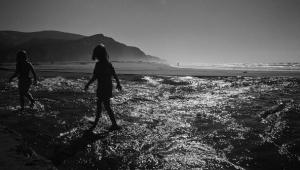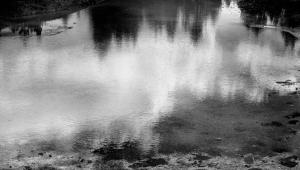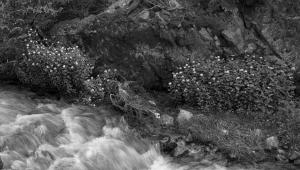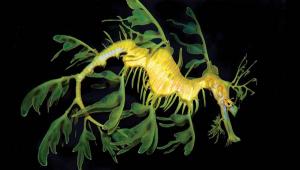Umbrella Options: Bounce & “Light-Through” For Different Effects
Shooting Into The Umbrella
Anne Marie is sitting on a stool with a 750 watt Lowel Omni (tungsten balanced) (www.lowel.com) pointed into a silver umbrella camera right (#1). The unit is 6 ft away and was raised to a height of 7 ft. Note that her key illumination is coming from that light source and the only fill she has is from a bounce card positioned camera left. The other illumination on her is a Mole-Richardson 200 watt Inky backlight (www.mole.com) on a Matthews Studio Equipment stand (www.msegrip.com) to separate her hair from the white background, and a second Lowel Omni pointed at the white seamless paper. The illumination is soft and even and there is still modeling on her face because of the shadow camera left (the opposite side of the umbrella) gives us a two to one lighting ratio. In my opinion, there is just enough light on the camera left side, although in the very slight shadow you can still see the twinkle in her eye. Without the eye being visible, the image would be too evenly lit.

All Photos © Chuck Gloman
Nikon D700, 24-110mm lens, f/5.6, 1/40th, 3200K, ISO 320.
Through The Umbrella
I sometimes prefer the look of the light shooting through the umbrella (#2). In this case, turn the top of the umbrella so that it is facing your model. Using this option, the umbrella is acting as diffusion to further soften the quality. The intensity is less than my first example but I still like the “look” shooting through an umbrella gives me. The texture of Anne Marie’s skin seems softer (and a bit darker) using the umbrella in this fashion. This still gives me a two to one lighting ratio although the metadata is exactly the same as in my first example. You can see my set up (#3). The light can actually be moved closer to the subject if you want more light on her face.

Nikon D700, 24-110mm lens, f/5.6, 1/40th, 3200K, ISO 320.
Two Lights
If you are looking for a more evenly lit set-up, I recommend using a hot shoe mounted wireless radio transmitter and two strobes to provide the key and fill illumination. With Ashleen, I have a transmitter mounted on my Nikon’s hot shoe; a Bowens Prolite 100 (www.bowensusa.com) 8 ft from Ashleen camera right and raised to a height of 7 ft. The Prolite is pointed into a white (matte) Phototech umbrella (www.phototechinc.com). Another Prolite 100 was mounted at the same height but 20 ft camera left. This equipment gives me very even, flat lighting with a white paper background. The output from these bounce/reflected sources bathed the background with illumination because the falloff (the light’s throw) is very deep (#4).
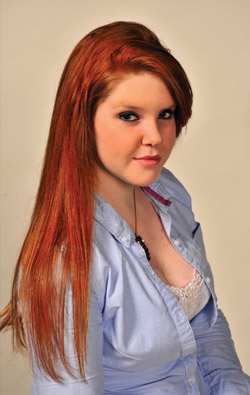
Adjusting the Prolites to their minimum output, Ashleen was still bathed in light. Strobes have a much higher output than tungsten light fired into an umbrella and is usually more comfortable on the model because the full output is only achieved when the shutter is triggered. Another difference with the strobes is that they are closer to a daylight balance, often giving a cooler color temperature if your camera is set to daylight color balance.
Nikon D700, 24-110mm lens, f/9, 1/100th, flash color balance, ISO 200.
Here’s a slightly revised set-up, with the camera left Prolite 100 being much farther away (#5). These types of lights are fantastic for shooting numerous portraits by just adjusting the strobe’s output or moving one of the units closer or farther away from the talent.

Chuck Gloman is an associate professor and the Chair of the TV/Film Department at DeSales University. He may be reached at chuck.gloman@desales.edu.
- Log in or register to post comments


